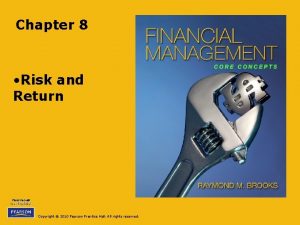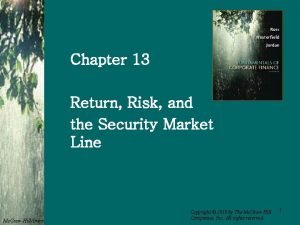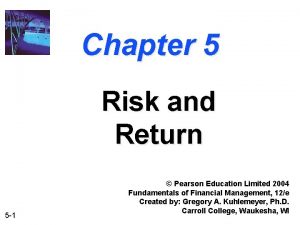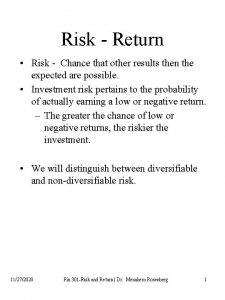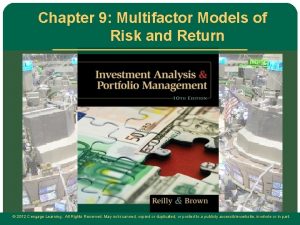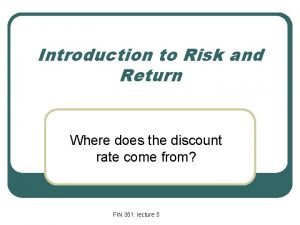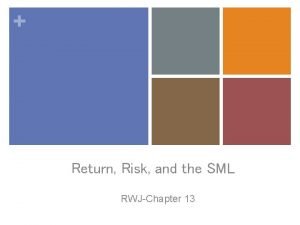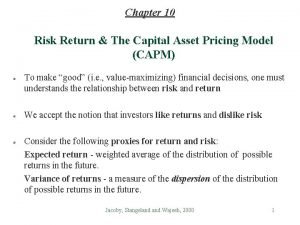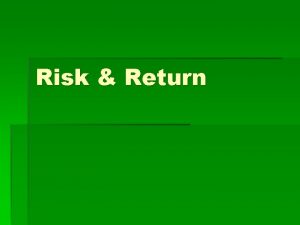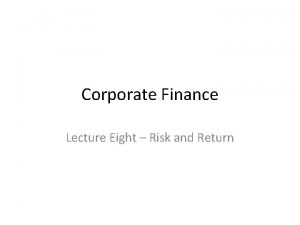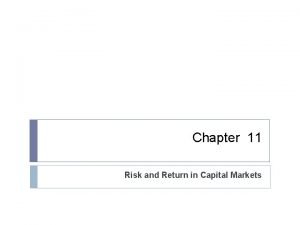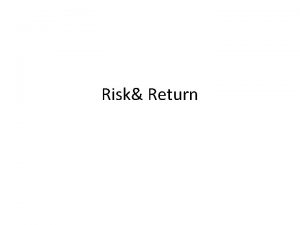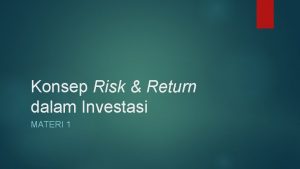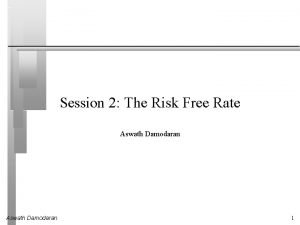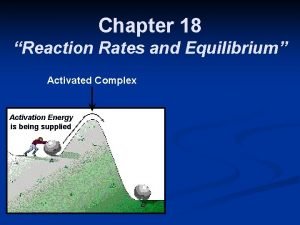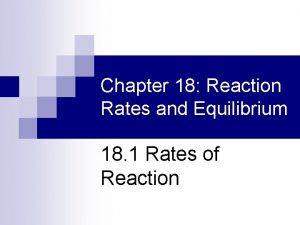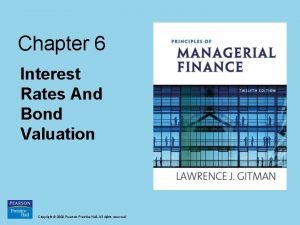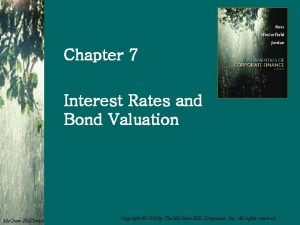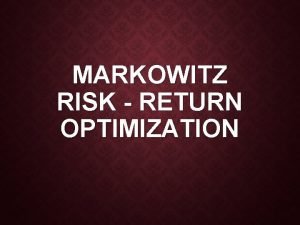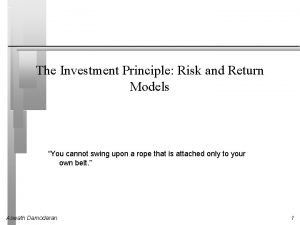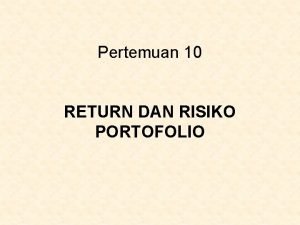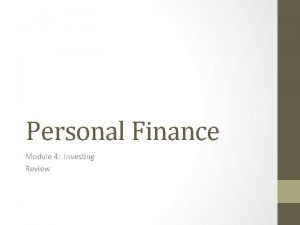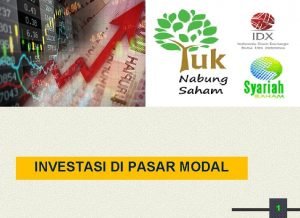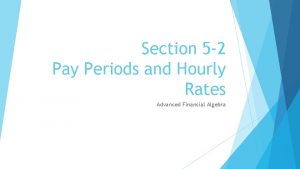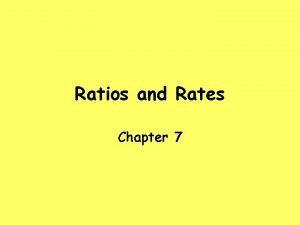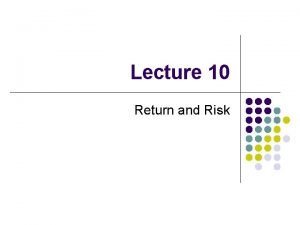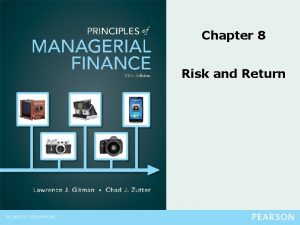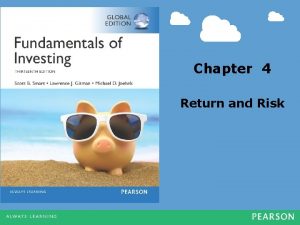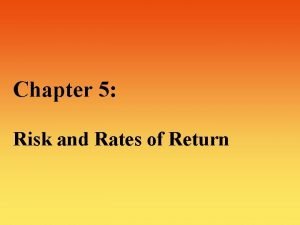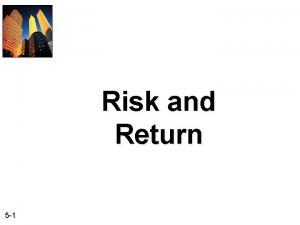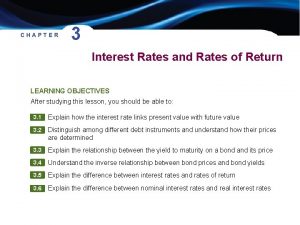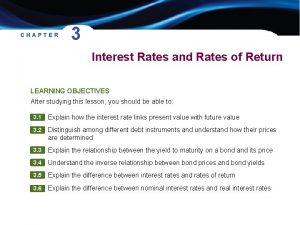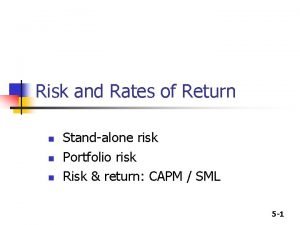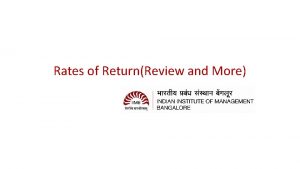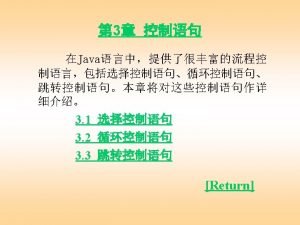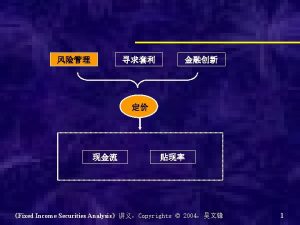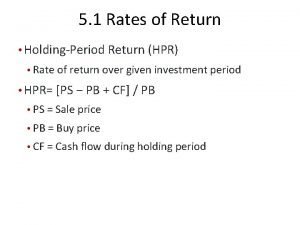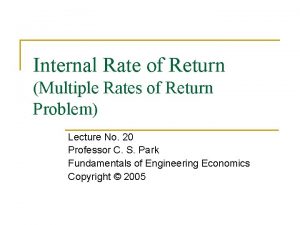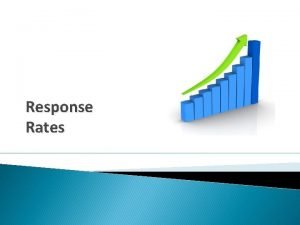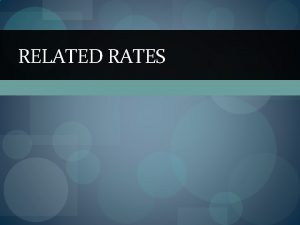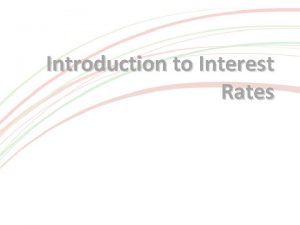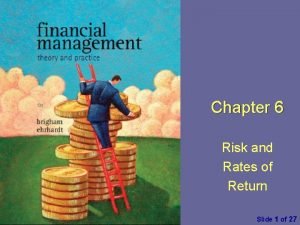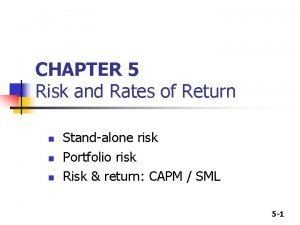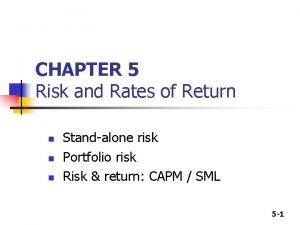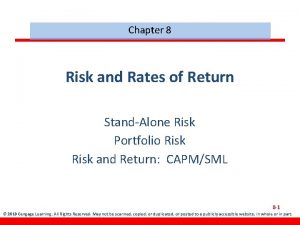Chapter 5 Risk and Rates of Return Risk









































- Slides: 41

Chapter 5: Risk and Rates of Return

Risk and Rates of Return: 2

Chapter Outline: u. Types of Return. u. Types of Risk. u Expected Rate of Return. u. The Measurement of Risk. u. The Return of A Portfolio. u. The Concept of Beta. 3

Types of Return: u. Expected Return. u. Required Return. u. Realized Return. u. Expected Return Expressed as a Probability. u. Investment returns. 4

Expected Return: u. The return that an investor expects to earn on an asset, given its risk, price, growth potential, etc. 5

Required Return (K) : u. The return that an investor requires on an asset given its risk and market interest rates. u. The required return for bearing a certain level of risk. 6

Realized Return: u. The sum of income and capital gains earned on an investment. 7

Expected Return Expressed as a Probability: u. The expected value is the sum of each outcome multiplied by the probability of occurrence. 8

Investment returns: The rate of return on an investment can be calculated as follows: (Amount received – Amount invested) Return = ____________ Amount invested For example, if $1, 000 is invested and $1, 100 is returned after one year, the rate of return for this investment is: ($1, 100 - $1, 000) / $1, 000 = 10%. 9

Types of Risk: u. What is Risk? u. Nondiversifiable Risk. u. Diversifiable Risk. u Investment Risk. 10

What is Risk? u The chance that some unfavorable event will occur. u. The possibility that an actual return will differ from our expected return. u. Uncertainty in the distribution of possible outcomes. 11

Nondiversifiable Risk: u. Known as Market risk or Systematic risk. u. This type of risk can not be diversified away. 12

Nondiversifiable Risk: u. Unexpected changes in interest rates. u. Unexpected changes in cash flows due to tax rate changes, foreign competition, and the overall business cycle. u. Political Events u. International Events 13

Diversifiable Risk: u. Known as Company-unique risk or Unsystematic risk. u. This type of risk can be reduced through diversification. 14

Diversifiable Risk: u. A company’s labor force goes on strike. u. A company’s top management dies. u. A huge oil tank bursts and floods a company’s production area. 15

What is investment risk? u. Two types of investment risk t Stand-alone risk t Portfolio risk u. Investment risk is related to the probability of earning a low or negative actual return. u. The greater the chance of lower than expected or negative returns, the riskier the investment. 16

What is investment risk? t. Stand-alone risk: The risk an investor would face if he or she held only one asset. t. Portfolio risk: The risk an investor would face if he or she held more than one assets, an investment portfolio. 17

Expected Rate of Return: u. The rate of return expected to be realized from an investment; the weighted average of the probability distribution of possible results. 18

Calculating the Expected Rate of Return: u See the example in the book pages 172 -173. 19

The Measurement of Risk: u Measuring the stand alone risk using the standard deviation. 20

Standard Deviation as a Measure of Risk: u. It can serve as an absolute measure of return variability. uthe higher the standard deviation, the greater the uncertainty concerning the actual outcome u. We can use it to determine the likelihood that an actual outcome will be greater or less than a particular amount 21

Standard Deviation: u. Standard deviation is a measure of the dispersion of possible outcomes. u. The greater the standard deviation, the greater the uncertainty, and therefore , the greater the risk. 22

Standard Deviation Calculation: 23

Standard Deviation Calculation: u See the example in the book page 175. 24

Calculating the Return Range: u it can be calculating as follow: Return Range= k + and - STDV 25

Coefficient of Variation (CV) A standardized measure of dispersion about the expected value, that shows the risk per unit of return. 26

The Return of A Portfolio: u. Portfolio: is a combination of two or more securities or assets u. Investors rarely place their entire wealth into a single asset or investment (risky). Rather, they construct portfolio or group of investment u. Combining several securities in a portfolio can actually reduce overall risk. 27

Diversification: u. Investing in more than one security to reduce risk. u. If two stocks are perfectly positively correlated, diversification has no effect on risk. u. If two stocks are perfectly negatively correlated, the portfolio is perfectly diversified. 28

Returns distribution for two perfectly negatively correlated stocks (ρ = -1. 0): Stock W 25 Stock M 25 Portfolio WM 25 15 15 0 0 15 0 -10 -10 29

Returns distribution for two perfectly positively correlated stocks (ρ = 1. 0): Stock M’ Portfolio MM’ 25 25 25 15 15 15 0 0 0 -10 -10 30

Portfolio Return: u. The expected return of a portfolio is simply a weighted average of the expected return of the securities comprising that portfolio 31

Calculating Portfolio Standard Deviation: page 182. 32

Failure to diversify: u. If an investor chooses to hold a one-stock portfolio (exposed to more risk than a diversified investor), would the investor be compensated for the risk they bear? t NO! t Stand-alone risk is not important to a welldiversified investor. t Rational, risk-averse investors are concerned with σp, which is based upon market risk. t No compensation should be earned for holding unnecessary, diversifiable risk. 33

The Concept of Beta : u. Measures a stock’s market risk, and shows a stock’s volatility relative to the market. u. Indicates how risky a stock is if the stock is held in a well-diversified portfolio. u. Average relationship between a stock’s returns and the market’s returns 34

Beta Coefficients: u. The market’s beta is 1. u. A firm that has a beta = 1, this firm’ stock no more no less riskier than the market. u. A firm with a beta > 1, this firm’s stock is more risky than the market. u. A firm with a beta < 1, this firm’s stock is less risky than the market. u. Most stocks have betas in the range of 0. 5 to 1. 5. 35

The Calculation of Beta Coefficient: u. Run a Regression Analysis of past returns on a stock versus past returns on the market. u. The slope of the regression line, i. e. the characteristic line, is defined as the beta coefficient. u. The greater the slope of the characteristic line for a stock, the greater its systematic 36

High and Low Betas: 37

Can the Beta of a Stock be Negative? u. Yes, if the correlation between Stock and the market is negative. u. If the correlation is negative, the regression line would slope downward, and the beta would be negative. u. However, a negative beta is highly unlikely. 38

Beta and the Security Market Line (SML): u. The greater the beta of a stock, the greater the relevant risk of that stock, and the greater the return required. u. Assume that unsystematic risk is diversified away, the required rate of return for a stock is calculated using CAPM equation: 39

Volatility Versus Risk: u Earning Volatility does not necessarily imply investment risk. u Earning Volatility could imply risk depending on the causes. u Stock price volatility does signify risk. 40

41
 Chapter 8 risk and rates of return problem solutions
Chapter 8 risk and rates of return problem solutions Unit rate vocabulary
Unit rate vocabulary Proportions guided notes
Proportions guided notes Ratios rates and unit rates
Ratios rates and unit rates Ratios rates and unit rates
Ratios rates and unit rates Financial management chapter 8 risk and return
Financial management chapter 8 risk and return Chapter 13 return risk and the security market line
Chapter 13 return risk and the security market line Chapter 5 risk and return
Chapter 5 risk and return Risk and return
Risk and return Risk and return
Risk and return Risk and return
Risk and return Multifactor models of risk and return
Multifactor models of risk and return Introduction to risk and return
Introduction to risk and return Risk and return
Risk and return Calculate expected portfolio return
Calculate expected portfolio return Contoh soal risk and return
Contoh soal risk and return Difference between risk and return
Difference between risk and return Difference between risk and return
Difference between risk and return Risk and return
Risk and return Konsep risk and return
Konsep risk and return Market risk credit risk operational risk
Market risk credit risk operational risk Damodaran risk free rates
Damodaran risk free rates Reaction rates and equilibrium worksheet answers chapter 19
Reaction rates and equilibrium worksheet answers chapter 19 Chapter 7 interest rates and bond valuation
Chapter 7 interest rates and bond valuation Chapter 18 reaction rates and equilibrium answer key
Chapter 18 reaction rates and equilibrium answer key Chapter 18 reaction rates and equilibrium
Chapter 18 reaction rates and equilibrium How to find the price of a bond
How to find the price of a bond Chapter 6 interest rates and bond valuation
Chapter 6 interest rates and bond valuation Chapter 7 interest rates and bond valuation
Chapter 7 interest rates and bond valuation Chapter 6 interest rates and bond valuation
Chapter 6 interest rates and bond valuation Markowitz model of risk return optimization
Markowitz model of risk return optimization Risk return principle
Risk return principle Pengertian return dan risiko
Pengertian return dan risiko The basic rule of a risk-to-return relationship is that …
The basic rule of a risk-to-return relationship is that … Pengertian investasi
Pengertian investasi Residual risk and secondary risk pmp
Residual risk and secondary risk pmp Business risk and financial risk leverage
Business risk and financial risk leverage Attributable risk
Attributable risk Parirt
Parirt Ssema
Ssema 6-2 pay periods and hourly rates
6-2 pay periods and hourly rates Is a ratio a rate
Is a ratio a rate
